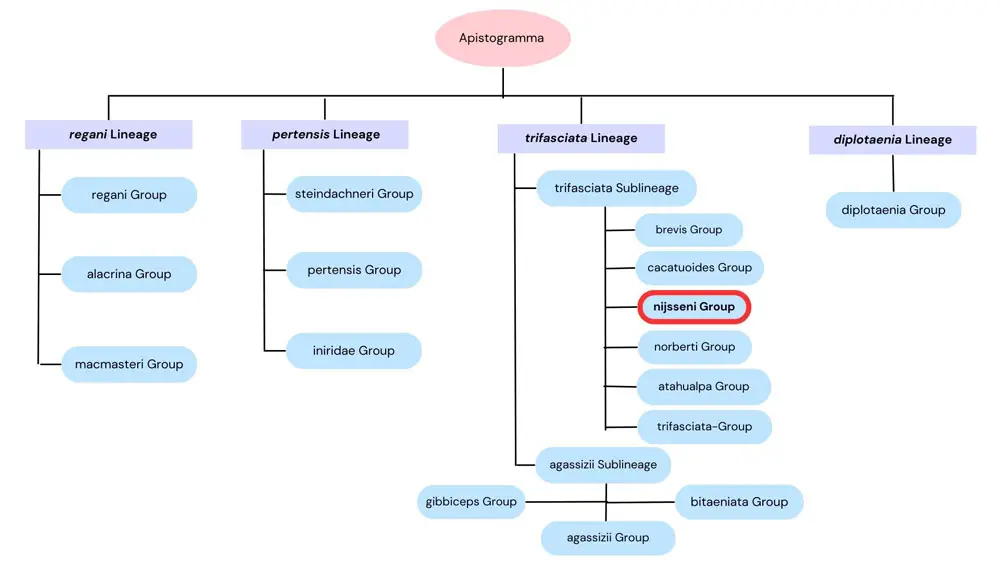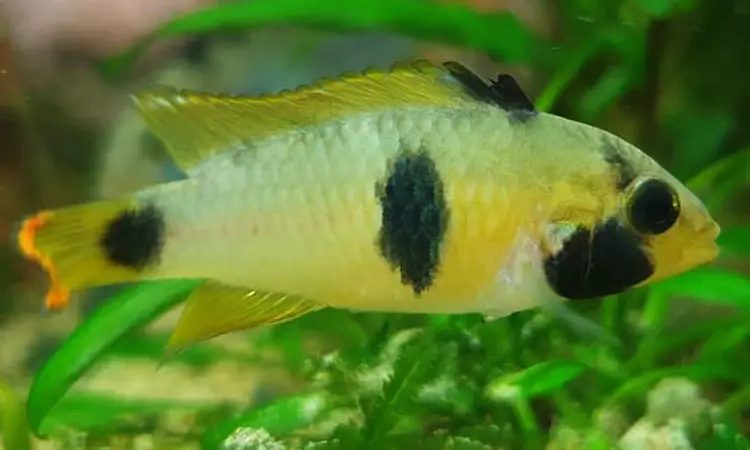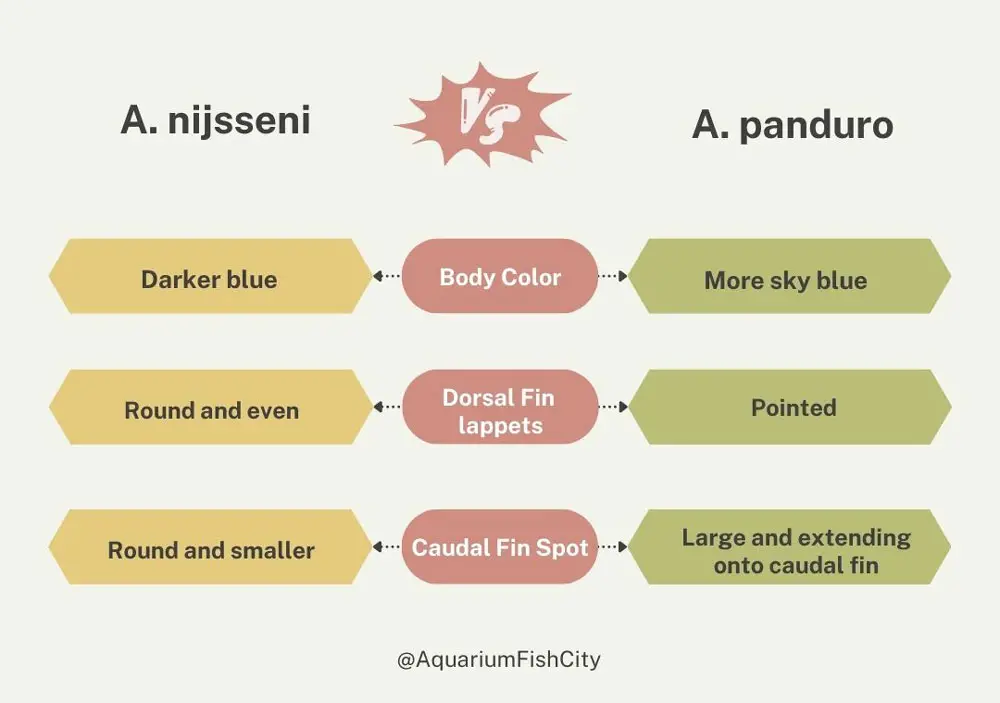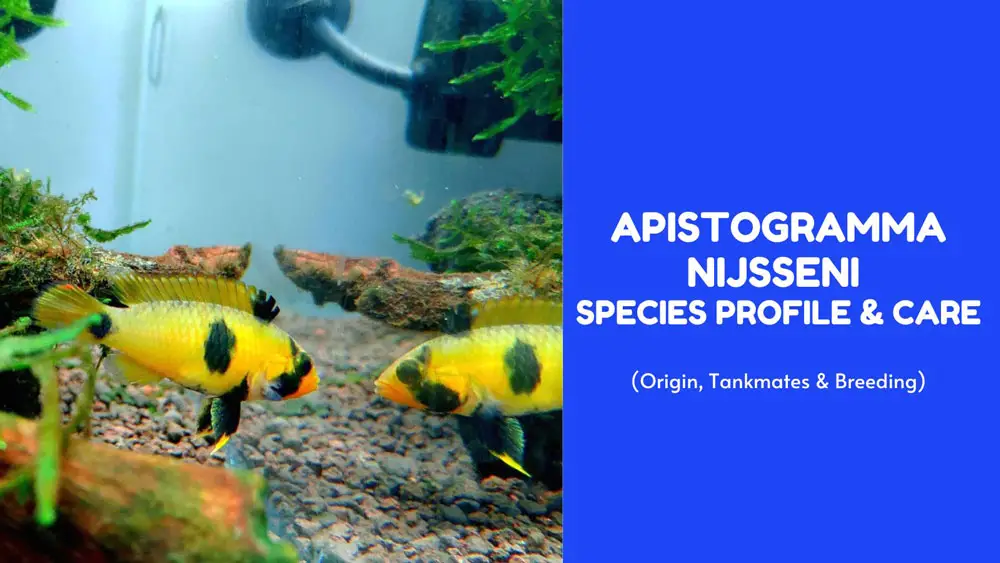The Apistogramma nijsseni, also known as the panda dwarf cichlid, is beloved by all who have owned them.
However, like most members of the Nijsseni group, the Apistogramma nijsseni is a true blackwater fish and tends to be relatively aggressive during the spawning season.
That said, these fish are not recommended for beginner hobbyists due to their specific water parameters requirements and habitat desires.
If you commit to owning and breeding this beautiful little cichlid, then read on!
| Scientific Name: | Apistogramma nijsseni |
| Common Name: | Nijssen’s Dwarf Cichlid, Dwarf Panda Cichlid, Panda Apistogramma, A180. |
| A-number: | A180 |
| Origin: | Río Carahuayte and Río Copal rivers in southern Peru |
| Family: | Cichlidae |
| Lineage: | trifasciata |
| Group: | eijsseni |
| Max Size: | Males: 3.3 inches (8.5 cm); Females: 2.4 inches (6 cm) |
| Social: | Semi-aggressive |
| Care: | Intermediate |
| Lifespan: | 2 ~ 5 years |
| pH: | 4.0 – 6.0 |
| Temperature: | 75-79° F (24-26 °C) |
| TDS: | < 20 |
| Diet: | Carnivore |
| Tank Size: | 30 gallons for a pair |
Distribution & Habitat
The Apistogramma nijsseni is native to southern Peru, specifically in the Río Carahuayte and Río Copal rivers, which are tributaries of the Río Ucayali River, the main headstream of the Amazon River.
It lives in small, slower blackwater creeks, streams, and rivers where it hides among piles of leaf litter and wood in the riverbed. The water is stained with tannins from decaying plant material, which makes it naturally acidic and soft. (We’ll talk about the appropriate water parameters later in the article.)
This native habitat is usually covered by very dense rainforests, allowing very little light to penetrate the canopy.
Etymology & Taxonomy

The scientific name “nijsseni” is named after a Dutch ichthyologist, Dr. Han Nijssen (1935– 2013), who discovered several species of Corydoras and published many scientific papers on South American fishes.
A. nijsseni is a fairly new species of Apistogramma in the fish trade. This pretty apisto was first discovered and introduced outside of its native range by Patrick de Rham between 1979 and 1981[1] but was not bred in captivity until 1983.
Since 1995, this species has been regularly imported in small quantities to Europe, Japan, and the U.S. It is relished by experienced Apistogramma breeders alike. Its close relative, A. panduro (Blue Panda Cichlid), seems to be even more popular and readily available in pet stores.
You might find them sold under several trade names, including Nijssen’s Dwarf Cichlid, Dwarf Panda Cichlid, Panda Apistogramma, or assigned A-number: A180.
Apistogramma is a large genus of dwarf cichlids, with nearly 100 recognized species and over 400 yet to be described.
To aid in proper identification, ichthyologists and enthusiasts have classified Apistos into various species complexes and groups within four lineages [2] based on morphology and distribution patterns. These classifications have been confirmed by recent genetic studies.
A. nijsseni belongs to the Nijsseni Group in the Trifasciata Lineage. Other group members include A. payaminonis, A. panduro, A. martini, A. baenschi, A. pantalone, and A. rositae.
In order to help you understand the hierarchical relationship of A. nijsseni within the genus, we have included a dendrogram below (with thanks to Mike Wise).

Apistogramma nijsseni Identification
As you can see in the diagram above, the trifasciata Lineage can be divided into two sublineages. A. nijsseni is a member of the trifasciata Sublineage. Most species in this Sublineage are usually more robust fish with somewhat deeper, laterally compressed bodies. Additionally, adult males develop extended, serrated dorsal fins compared to those in agassizii Sublineage.

The Nijsseni group species exhibit evolutionary characteristics and like to inhabit areas of blackwater. They are characterized by the following typical traits:
- Adult fish possess no lateral line, but it’s visible in young juveniles.
- A distinct lateral spot is more obvious at the mid-body in females due to their body color.
- A black patch over gills.
- A fairly large head with well-developed jaws and big lips.
- A dark pigmented branchiostegal membrane.
- A more rounded caudal fin, and it’s edged in red.
Identifying A. nijsseni from other species in the nijsseni Group isn’t always straightforward. Use the following descriptions to help you make positive identifications. [3]
| A. panduro | A. martini | A. baenschi | A. pantalone | A. rositae |
|---|---|---|---|---|
| 1. Sky blue body 2. Pointed dorsal fin lappets 3. Extended triangular caudal spot | Having a lyreate caudal fin | Pointed dorsal fin lappets | Having a lyreate caudal fin | Pointed dorsal fin lappets |
A. nijsseni Vs. A. panduro
Initially, A. panduro was considered a geographical variation of A. nijsseni. There are a few small differences between the Apistogramma nijsseni and the Apistogramma panduro in appearance, making it fairly easy for them to get confused with one another.
The primary difference between Apistogramma nijsseni and Apistogramma panduro is the shape of the spot on their caudal fins. The caudal fin spot on Apistogramma nijsseni is small and rounded, whereas Apistogramma panduro have a larger, triangular-shaped spot that extends all the way to the tail.

Apistogramma nijsseni Size
The Apistogramma nijsseni is a medium – to large-sized Apistogramma species. The total length of a male is 3.3 inches (8.5 cm), while the females are generally smaller, tending to only grow to 2.4 inches (6 cm).
Panda Dwarf Cichlid Care & Tank Setup
The care requirements for these species of nijsseni Group are very similar because they all come from acidic, tannin-filled blackwater streams and tributaries.
They are recommended for more experienced enthusiasts due to their specific need for water parameters to be kept within a certain range, particularly when you want to breed them.
Tank Size
Due to their aggressive nature and relatively large size of 3 inches, they are not suitable for the most commonly used 20-gallon aquarium tanks for Apistos.
The minimum tank size for a single pair of Apistogramma nijsseni is 30 gallons Breeder (36″ x 18″ x 12″). For those who want the best luck breeding them and observe their social behavior, we recommend keeping them in a large group of three males and 4-6 females in a 75-gallon tank (48″ x 18″ x 21″).
Also, it is advised that you ensure a tight tank cover, as these fish have been known to jump.
Water Parameters
Generally, captivity-bred specimens are adaptable enough to be kept in a wide range of water parameters, but for optimal care and breeding success, it is recommended that you keep their water parameters close to the following:
- Temperature: 75-79° F (24-26 °C)
- pH: 4.0 – 6.0
- TDS < 20 (Conductivity: < 50 µS/cm)
The Conductivity and pH levels are extremely important at breeding time, particularly with wild-caught individuals. To obtain such low-conductivity and acidic environments, a R/O unit with peat filtration is recommended.
Décor (Plants and substrate)
When setting up the tank and deciding what to fill it with, take into consideration the fish’s natural habitat and how they would live if they were still in the wild.
The white sand is the substrate of choice because, like their larger Geophagus cousins, they like to burrow down into it. Some bogwoods with lots of leaf litter will replicate the natural habitat in which the panda dwarf cichlids hide and lay their eggs.
Floating plants are highly recommended for Apistogramma nijsseni as they provide shade and make them feel more secure in the tank. Ensure the plants can withstand acidic conditions.
This species is territorial. Many different options can be used to provide them with plenty of territories, such as sunken logs, flowerpots, or coconut shells.
They prefer low-lighting environments, so while it is possible to use the plants as described above to achieve this effect, please bear this in mind when choosing the type of lightbulb that will be used in your tank.
Apistogramma nijsseni Diet and Feeding
Feed live foods when possible; frozen foods are accepted. Live or frozen black mosquito larvae, white mosquito larvae, daphnia, grindal worms, and artemia are good food sources.
Tank-raised fish sometimes accept small carnivorous pelleted or flake food. Apistos are bottom dwellers, so it is important to scatter the sinking food in different areas of the tank so that everyone can have a chance to get their fair share.
When conditioning fish for breeding, just provide live foods.
Behavior & Tank Mates
Members of the trifasciata lineage tend to be polygamous, usually forming breeding pairs rather than bonded pairs. Additionally, males can be extremely aggressive toward females who are not ready to spawn.
That’s why it’s best to have at least two females for every male in a breeding tank. Once a breeding pair has formed, other females should be separated to prevent them from attacking or killing.
In a display tank, suitable tankmates of Apistogramma nijsseni include dither fishes such as Pencilfish, Corydoras, Otos, and small tetras. Avoid having any nocturnal fish like Corydoras and Plecos in a breeding tank, as they might eat Apistos’ eggs.
Gender Differences
The genders can be differentiated by color, with the adult males having brighter blue coloring and a yellow belly, while the females are mostly yellow with black spots (these being responsible for their name). The male fish is generally larger, as is expected in most Apistogramma species.
Sexual differences are also discernible among young fish. The way to pick out female specimens is by the black markings located on their pelvic fins and the base of the dorsal fin, which are absent in male specimens.
Breeding the Apistogramma nijsseni
Breeding A. nijsseni is just like breeding A. panduro or other true blackwater Apistos in many ways, which can be challenging due to their need for very specific water conditions and choosy nature when it comes to mates.
Apistos are not nocturnal fish; community fish like corys and plecos may eat their eggs and offspring during the night. Furthermore, breeding fish can become aggressive and should be provided with ample hiding places and territories. Therefore, all attempts to breed Apistogramma nijsseni should be undertaken in a separate breeding tank without any other fish.
The biggest difficulty in breeding the Apistogramma nijsseni is providing your fish with the proper environment for successful breeding, especially with regard to maintaining appropriate water quality parameters such as TDS and pH levels.
Total Dissolved Solids (TDS) can significantly impact Apistos breeding more than pH levels. Studies have shown that high TDS levels can inhibit egg fertilization due to the presence of Ca2+ in water.
Aside from the TDS, the sex ratio among the fry is influenced by water pH and temperature. [4] When you have a low pH and high temperature, there will be more male fry and vice versa. Remember, if the pH is too high, the eggs will not develop.
Here are the optimized water quality parameters you should aim for:
- Temperature: 75-77° F (24-25 °C)
- pH: 5
- Conductivity: < 10 µS/cm
- KH: 0
- GH: 0
As mentioned, even if you have one male and female Apistogramma nijsseni, they may not be interested in breeding. These fish can be picky when it comes to potential breeding partners.
To acquire a breeding pair, keep them in a harem with at least two females for every male, depending on your tank size. Once a pair forms, remove the other fish before they mate to prevent aggression.
As you condition the pair by providing them with live food, you may observe their colors will intensify as they get ready to spawn.
Spawning will usually take place in a cave or any other spawning site that the female can find. The female will lay up to 70 eggs on the ceiling of the cave.
From the time the eggs are laid, the female becomes extremely protective and may attack or even kill the male who comes back to spawn again. In this case, the male should be removed.
The eggs will hatch within 2-3 days, and the fry become free swimming in another 7-8 days. Feed the fry newly hatched brine shrimp during the first couple of weeks.
Final Thoughts
While not for those just beginning their journey of caring for blackwater Apistogramma species, the Apistogramma Nijsseni is a beautiful addition to an experienced hobbyist collection.
If you maintain a suitable environment for these fish, they’re sure to return the favor with vivid displays of color and interesting social behavior.
References:
- de Rham, Patrick & S.O. Kullander. 1982. “Apistogramma nijsseni Kullander un nouveau Cichlidé nain pour l’aquarium”. Revue française d’Aquariologie et Herpetologie.
- Wise, Mike. 2021. Description, Distribution, and a proposed phylogeny of Apistogramma species-groups.
- ‘DATZ Book’, Südamerikanische Zwergcichliden / South American Dwarf Cichlids”
- Cichliden Atlas Band 1: Naturgeschichte der Zwergbuntbarsche Südamerikas. October 2000.





